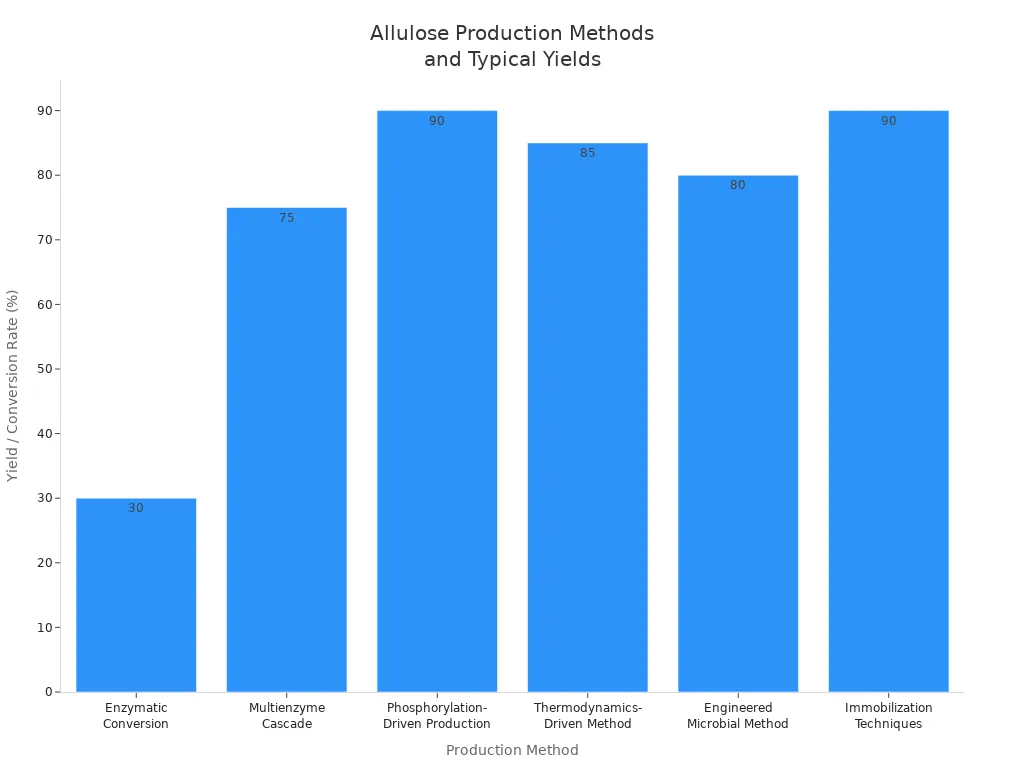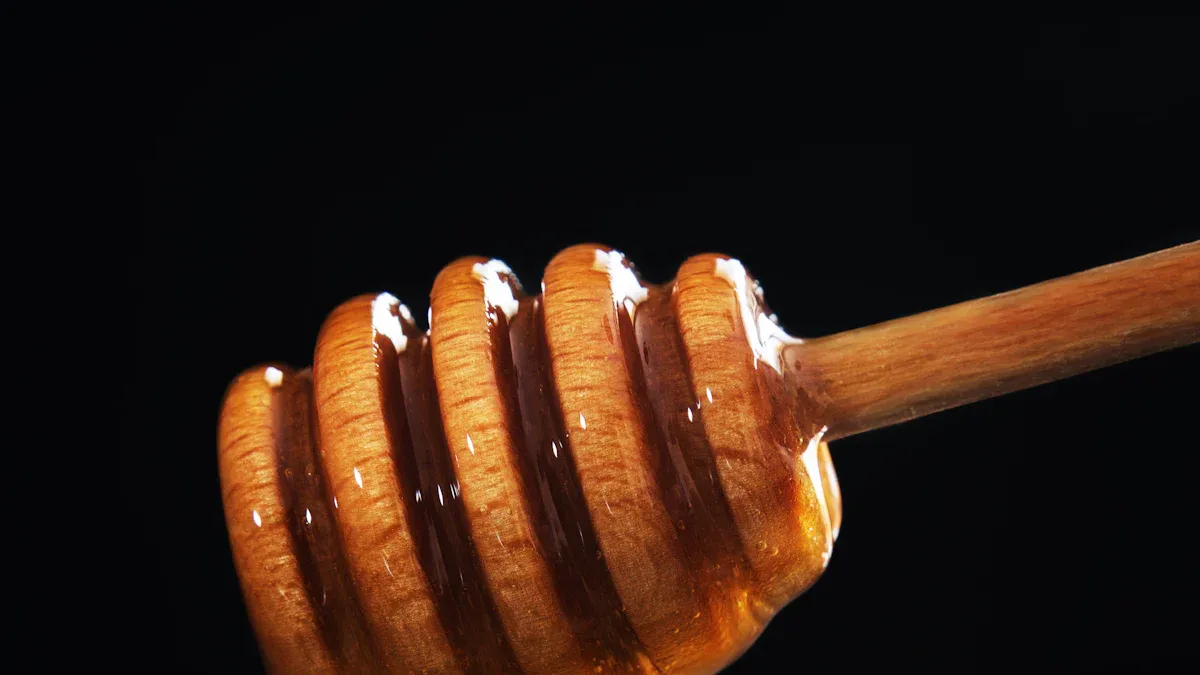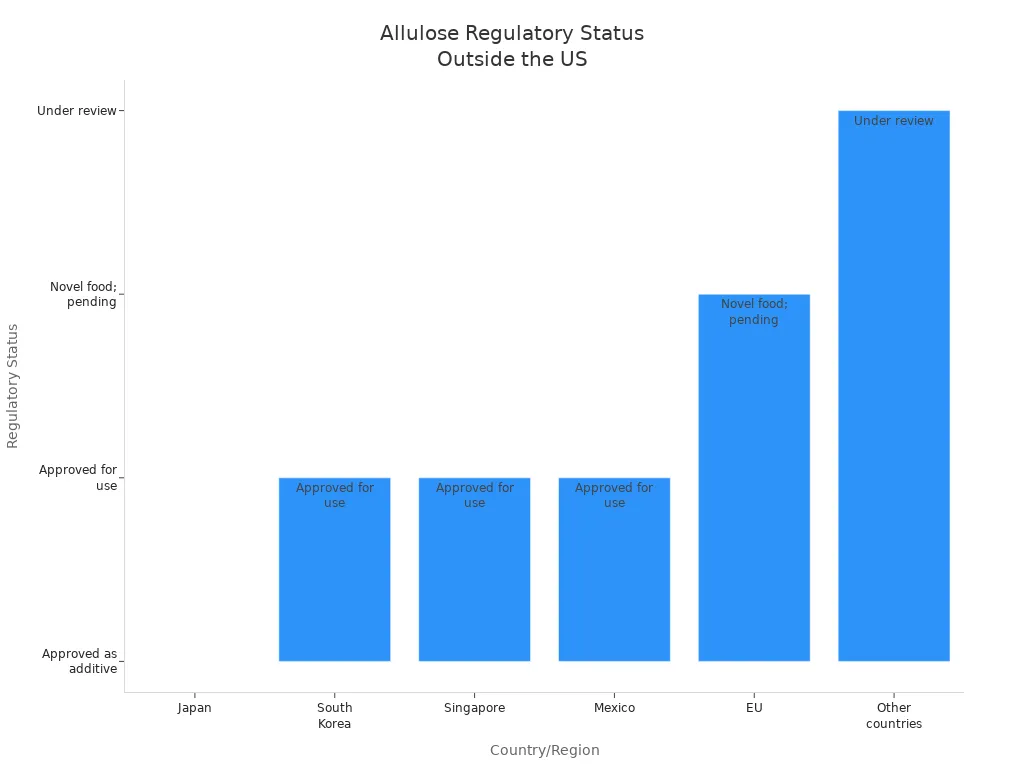Allulose is a rare sugar you can find in small amounts in foods like figs and raisins. Manufacturers create it from natural sources, such as beet sugar or maize, using special enzymes. This sweetener tastes like regular sugar but gives you only about 0.4 calories per gram, almost 90% fewer calories than table sugar. Many people choose allulose because it does not raise blood sugar, helps with weight control, and supports dental health.
| Metric | Value |
|---|---|
| Market Size (2023) | USD 283.4M |
| Market Size (2030) | USD 509.3M |
| CAGR (2024-2030) | 8.6% |
Key Takeaways
- Allulose is a natural sweetener that tastes like sugar but has about 90% fewer calories.
- It does not raise blood sugar or insulin, making it a good choice for people with diabetes or low-carb diets.
- Allulose helps protect teeth because mouth bacteria cannot use it to produce acids that cause cavities.
- You can use allulose as a 1:1 substitute for sugar in many recipes, but it browns faster and may need baking adjustments.
- Most people tolerate allulose well, but eating too much may cause mild digestive discomfort.
Allulose Basics

What Is Allulose
You may have heard that allulose is a rare sugar. Scientists call it a monosaccharide, which means it is a simple sugar with only one sugar unit. Allulose shares the same molecular formula as fructose and glucose, but its atoms are arranged differently. This small change at the third carbon atom makes allulose a C-3 epimer of fructose. Because of this, allulose interacts with water in a unique way and has different sweetness and solubility compared to other sugars.
- Allulose and fructose have the same chemical formula but differ at the carbon-3 position.
- This difference changes how allulose behaves in foods and drinks.
- Glucose, fructose, and allulose each have their own hydration and bonding patterns.
Natural Sources
You can find allulose in nature, but only in tiny amounts. Foods like figs, raisins, jackfruit, brown sugar, maple syrup, and wheat contain trace levels of allulose. For example, dried fruits such as figs and raisins have small amounts, but not enough for large-scale use. Because these foods hold so little allulose, companies do not rely on them for commercial production. Instead, they use other methods to make enough for food products.
Note: Allulose is present in natural foods, but the low concentration means you usually get it from processed products, not directly from fruits or grains.
Production
Most of the allulose you see in stores comes from special production methods. Manufacturers often start with corn or fructose. They use enzymes to turn fructose into allulose. Several methods exist, each with different yields and benefits.
| Production Method | Description | Typical Yield / Conversion Rate |
|---|---|---|
| Enzymatic Conversion | Uses D-allulose 3-epimerase to convert fructose to allulose; limited by thermodynamic equilibrium. | ~30% conversion due to equilibrium limit |
| Multienzyme Cascade | Sequential use of fructose isomerase and D-allulose 3-epimerase, especially for fruit juice substrates. | 75% conversion; 60% overall yield from fruit juice |
| Phosphorylation-Driven Production | Involves ATP-dependent enzymatic steps with ATP regeneration systems; uses enzymes like hexokinase and D-tagatose 3-epimerase. | Up to 90% conversion |
| Thermodynamics-Driven Method | Converts starch to glucose, then fructose, then allulose using enzymatic steps; optimizes natural energy dynamics. | Up to 85% yield |
| Engineered Microbial Method | Uses genetically modified E. coli with phosphorylation-dephosphorylation cycles to convert fructose to allulose. | 70-80% conversion, with potential for improvement |
| Immobilization Techniques | Enzyme immobilization on magnetic MOF nanoparticles or nano-beads to improve enzyme stability and reusability. | Enhances process efficiency and enzyme reuse; retains 90% activity after multiple cycles |

Today, companies prefer bio-enzymatic and microbial methods. These approaches use less energy and create less waste than older chemical processes. Some even use agricultural waste as raw material, making allulose production more sustainable and eco-friendly.
Allulose vs. Sugar

Taste
When you taste allulose, you notice a sweetness that feels very close to regular sugar. Sensory studies show that allulose gives about 70% of the sweetness of table sugar. You may find that it has a clean, pleasant flavor without the bitter or chemical aftertaste that some other sugar substitutes, like stevia or sucralose, often have. In yogurt and other foods, people often rate allulose as just as tasty as sugar, or even better. The sweetness from allulose starts and peaks at almost the same time as sugar, so you get a familiar sweet experience.
| Sweetener | Sweetness Compared to Table Sugar |
|---|---|
| Allulose | Approximately 70% |
Tip: If you want a taste close to sugar without unwanted aftertastes, allulose can be a good choice.
Calories
You might wonder how many calories you get from allulose compared to sugar. Sucrose, or table sugar, gives you about 4 calories per gram. Allulose, on the other hand, provides only 0.2 to 0.4 calories per gram. Your body absorbs most of the allulose, but it does not use it for energy. Instead, you excrete it unchanged, so it does not add many calories to your diet. The FDA allows food makers to label allulose as 0.4 kcal/g and does not count it as sugar on nutrition labels. This makes allulose a low-calorie sweetener that helps you cut down on energy intake.
Blood Sugar
If you need to watch your blood sugar, allulose offers a big advantage over regular sugar. Allulose has a glycemic index of 0, which means it does not raise your blood sugar at all. Scientific studies show that when you eat allulose with other carbs, it can even lower the rise in blood sugar after meals. For example, healthy adults who ate 5 to 10 grams of allulose with a meal had a 13–14% lower increase in blood sugar compared to those who did not. Allulose works by slowing down how fast your body absorbs glucose and by helping your liver store more sugar as glycogen. It also helps your body release GLP-1, a hormone that controls blood sugar and appetite. Regular sugar, in contrast, quickly raises both blood glucose and insulin levels.
| Clinical Evidence Aspect | Findings |
|---|---|
| Effect on Postprandial Blood Glucose in T2DM Patients | Significant reduction in postprandial glucose levels and time above range (TAR), supporting glycemic control benefits. |
| Effect on Insulin Levels | Trend toward lowering insulin area under the curve (AUC) without statistical significance, suggesting reduced insulin secretion without overstimulation. |
| Comparison with Other Sweeteners | Allulose reduces glucose AUC without increasing insulin AUC, unlike sucralose which increases insulin AUC in obesity; stevia reduces both glucose and insulin AUC. |
| Mechanistic Insights | Inhibition of α-glucosidase, slower glucose absorption via shared transporters, stimulation of glycogen synthesis, induction of GLP-1 release. |
| Study Limitations | Small sample sizes, short durations, heterogeneity in doses and administration forms; limited insulin AUC data restricts strong conclusions. |
| Recommendations for Future Research | Larger, long-term trials needed to confirm effects on insulin sensitivity, metabolic health, and optimal dosing. |
| Clinical Implications | Allulose may complement existing T2DM interventions (diet, physical activity, pharmaceuticals) with potential synergistic effects alongside GLP-1 receptor agonists. |
- Allulose passes through your body with little change.
- Sucrose breaks down into glucose and fructose, raising blood sugar and insulin.
- Allulose does not turn into fat or block fat burning.
- Allulose may help control weight and improve insulin sensitivity.
Tooth Health
You may know that sugar can cause cavities. Bacteria in your mouth feed on sugar and make acids that damage your teeth. Allulose does not work the same way. The bacteria in your mouth cannot use allulose to make acid, so it does not cause tooth decay. This makes allulose a tooth-friendly sweetener. If you want to protect your teeth while enjoying sweet foods, allulose can help you do that.
Health & Safety
FDA Status
You might wonder if this sweetener is safe. The U.S. Food and Drug Administration (FDA) granted it Generally Recognized as Safe (GRAS) status in 2012. This decision came after experts reviewed scientific data and found no safety concerns for its use in foods and drinks. The FDA allows you to use it as a general-purpose sweetener wherever you would use sugar or fructose. In the United States, you will see it listed as an ingredient, but it does not count toward total or added sugars on nutrition labels.
Other countries have their own rules. Many places in Asia and Latin America approve its use as a sweetener. In Europe, the approval process is still ongoing. Some countries, like the United Kingdom and Canada, classify it as a novel food and require more safety data before full approval.

Side Effects
Most people can enjoy this sweetener without problems. Some may notice mild digestive issues if they eat too much. These effects usually happen at high doses and go away when you lower your intake.
| Side Effect Category | Description | Notes on Dosage and Frequency |
|---|---|---|
| Digestive Issues | Gas, bloating, diarrhea, constipation | Most common side effects; associated with high doses |
| Allergic Reactions | Rare; symptoms include hives, rash, itching, swelling, difficulty breathing | Rare but reported; requires immediate medical attention |
| Blood Sugar Effects | Reduction in blood sugar levels | Important for diabetics to monitor |
| Other Side Effects | Headaches, fatigue, dizziness | Less common |
| Dosage Tolerance | Safe intake approx. 0.4 g/kg body weight at once or 0.9 g/kg per day | Higher amounts may cause abdominal discomfort and diarrhea |
Health experts recommend a maximum single dose of 0.4 grams per kilogram of body weight and a daily limit of 0.9 grams per kilogram. For a person weighing 150 pounds (68 kg), this means about 27 grams per serving and 61 grams per day.
Diet Suitability
You can use this sweetener if you have diabetes. Studies show it does not raise blood sugar and may even help control it. People with type 2 diabetes saw lower blood sugar spikes after meals when they used it. It also helps protect insulin-producing cells and may support healthy appetite control.
If you follow a keto or low-carb diet, this sweetener fits your needs. Your body does not metabolize it for energy, so it does not interfere with ketosis. Nutrition experts agree it is keto-friendly and works well in baking and cooking.
Allulose in Recipes
Substitution
You can swap sugar with this sweetener in many recipes. Most cooks use a 1:1 ratio when replacing sugar. This means you use the same amount of sweetener as you would sugar. It works well in doughs, batters, and fillings. You get a similar taste and texture to sugar.
- Closely mimics the taste and texture of sugar.
- Works as a 1:1 substitute in most baking recipes.
- May need to adjust baking time and temperature because it browns faster.
You often see this sweetener in cakes, cookies, biscotti, and scones. Many people use it in cheesecakes, frostings, puddings, jams, and marshmallows. It also works for caramelizing nuts and making keto caramel desserts. Ice cream and sorbet recipes use it too. People like it for its sugar-like taste and caramelizing ability. If you want to try it, remember to check your recipe and watch for browning.
Tip: If you want more sweetness, you can mix this sweetener with stevia or another high-intensity sweetener.
Cooking & Baking
This sweetener changes how your baked goods look and feel. It browns faster than sugar. You may notice a deeper color and a caramel flavor in cookies and cakes. In cookies, it helps create a golden color and a chewy texture. In cakes, it keeps them moist and tender for longer.
| Aspect | Performance Compared to Sugar |
|---|---|
| Browning | Browns more quickly, gives a caramelized flavor, ideal for cookies and cakes. |
| Texture | Holds moisture well, creates a tender crumb, helps cakes stay soft. |
Bread recipes act a bit differently. Bread made with this sweetener looks whiter and has a firmer texture. The dough may rise more slowly, but longer fermentation can help. Bakers often use blends of sweeteners or add fibers to keep the right texture and moisture.
- Browns faster, so lower oven temperature or shorter baking time may help.
- Less sweet than sugar, so you might want to combine it with other sweeteners.
- Adding fibers or bulking agents can improve texture and shelf life.
Note: If you replace all the sugar, you may need to adjust your recipe to keep the best taste and texture.
You now know that allulose stands out from sugar in several important ways:
- It contains about 0.4 calories per gram, much less than sugar.
- It does not raise blood sugar or insulin levels.
- Studies show it may help lower body fat and support weight management.
- Most people tolerate it well, but some may notice mild stomach upset if they eat too much.
| Consider When Choosing a Sweetener | Why It Matters |
|---|---|
| Your health goals | Allulose can help reduce calorie and sugar intake. |
| Diet type | It fits keto and diabetes-friendly diets. |
| Personal tolerance | Start slowly to see how your body reacts. |
Always talk to a healthcare professional before making big changes to your diet. Understanding sugar alternatives helps you make the best choices for your health.
FAQ
Is allulose safe for children?
You can give allulose to children in moderate amounts. Studies show it is safe for most people. Start with small servings to check for any stomach upset. If you have concerns, ask your child’s doctor.
Can you use allulose if you have diabetes?
Yes, you can use allulose if you have diabetes. It does not raise blood sugar. Many people with diabetes choose it as a sweetener. Always check with your healthcare provider before making changes to your diet.
Does allulose taste exactly like sugar?
Allulose tastes very close to sugar. You may notice it is a bit less sweet. Most people cannot tell the difference in recipes. It does not leave a bitter or chemical aftertaste.
Tip: Mix allulose with other sweeteners if you want a stronger sweetness.
Can you cook and bake with allulose?
You can use allulose in most recipes. It browns faster than sugar and gives baked goods a golden color. Lower the oven temperature or shorten baking time for best results.
- Works well in cookies, cakes, and sauces
- Keeps baked goods moist

